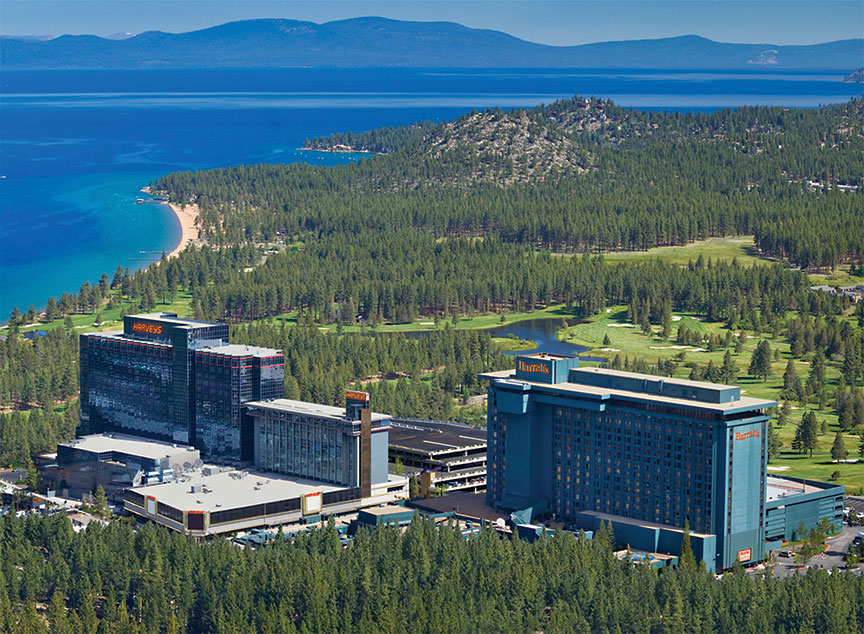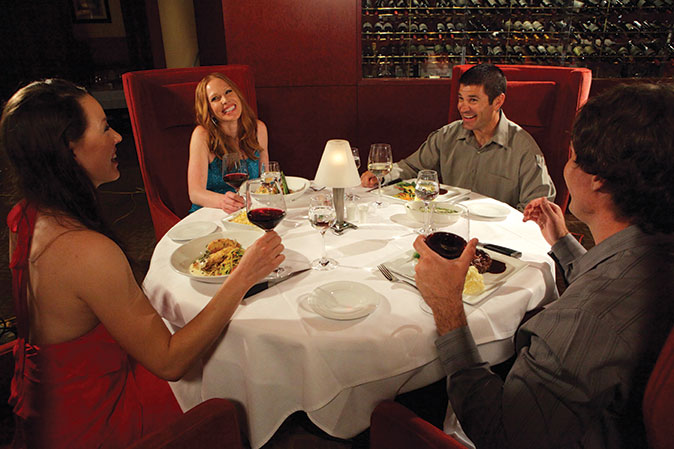
17 Feb A New Hand in Tahoe
With gaming’s decline, Tahoe’s casino resorts head in a new direction
The legend of Lake Tahoe rests largely upon the gold-steeped images of its past, when the affluent mixed a predilection for the good life with a penchant for games of chance. Particularly in the second half of the twentieth century, the casinos were a place to be seen, a place where luminaries from the entertainment universe rubbed shoulders with glamour-hungry mobsters at the blackjack table. Politicians, businessmen, singers and moviemakers mingled with those desperately bent on becoming part of the vanity fair.
That era has disappeared like last year’s snowpack. For those who market Lake Tahoe, gaming and the high-class revelry that signified Lake Tahoe in the time of Frank Sinatra, John F. Kennedy and Marilyn Monroe is no longer the centerpiece of their pitch. With casino floor revenues declining in a seemingly irreversible trend, gaming is becoming an afterthought for Tahoe casinos, a “by the way, we also have gaming” addendum to the conversation.
The Lake Tahoe and Reno communities are mired in an arduous transition as they attempt to swing the spotlight toward the area’s other well-deserved
reputation as an outdoor recreational mecca.
No doubt the unmatched beauty of the geography and the vast array of outdoor activities should, in theory, make it easy.
However, there’s a rub.
Lake Tahoe’s infrastructure and hospitality industry was largely founded on catering to the now-bygone gaming-dominant tourist industry. And, while Lake Tahoe’s physical environment is far superior to similar markets around the country, it hasn’t crafted its built environment and infrastructure to accentuate rather than detract from the geographical amenities.
The Great Recession and Indian Casinos
In 2008, the entire world economy suffered a staggering blow, but the Lake Tahoe economy, already susceptible to the boom-and-bust cycles endemic to a tourism-based industry, was especially hard-hit. The factors in Tahoe’s economic decline were many, but regional leaders agree an over-reliance on gaming played a role in the demise.
In 2000, California voters passed Proposition 1A, which permitted casino-style gambling on Native American land. In the 14 years since, casinos have proliferated to the tune of 44 in Northern California and more than 160 throughout the Golden State. They produce billions of dollars in revenue.
“One of the main things that happened to damage gaming in both Tahoe and Reno was that in California, particularly along Highway 50 and Interstate 80, different development groups have been able to open world-class casinos,” says Mark Nichols, an economics professor at the University of Nevada, Reno. “Listen, if you are coming to Lake Tahoe, not to ski or hike, but just to gamble because that’s all your interest is, you are passing newer, arguably better casinos. I don’t think people come up here because Frank Sinatra once owned the Cal Neva. I don’t think people care about that so much anymore.”
Lake Tahoe is particularly reliant on tourists from the Bay Area and other parts of California in proximity to the Basin as 70 percent of tourism is travelers within driving distance, says Betty “B” Gorman, CEO of the Lake Tahoe South Shore Chamber of Commerce.
Casinos being hurt by emerging competition is not unique to the California/Nevada dynamic, as states nationwide have been losing tax revenue to adjacent jurisdictions. Many have begun easing or eliminating regulations on gaming institutions. This trend is embodied in Atlantic City, once the East Coast version of Las Vegas, which witnessed five casinos close in 2014 alone.
“Restrictions on gaming were mainly a moral qualm largely due to the casinos’ connection to organized crime,” Nichols says. “But when major corporations started to get into the business, that reputation of gambling as a vice faded.”
In South Lake Tahoe, gaming revenue has declined 32 percent from roughly $304 million in 2008 to about $208 million in 2013. The story is similar on the North Shore, where gaming declined 21 percent from about $34 million to around $27 million. Reno has also suffered a dramatic 20 percent decline, falling from $677 million to around $550 million over the same time period.

Photo courtesy Harrah’s Lake Tahoe
NightClubs and Restaurants
It’s clear to Reno and Tahoe Basin casino managers that they need to move beyond the gaming floor.
The Tahoe Biltmore on the North Shore successfully secured government approval to fully renovate its property, which included a nearly 10 percent reduction in casino floor space.
While Boulder Bay, as the project was dubbed during the approval process, hasn’t been built yet, it introduced the trend of reducing the imprint of casino floor space relative to the overall resort.
Radovan Criswell, a Napa, California-headquartered real estate development company, is working on a dramatic renovation of the Cal Neva, the now-dilapidated casino once owned by Frank Sinatra. The disrepair is so pervasive that any attempts at putting Band-Aids on the property is insufficient, says co-owner Robert Radovan.
As such, Radovan has hired prominent interior designers and landscape architects to refurbish the exterior appearance of the building. The company will put the majority of its marketing emphasis in fine dining and high-end retail with gaming placed distinctly on the back burner.
When Sinatra’s old digs finally do open (reportedly by 2016), the casino floor space will be whittled to 6,000 square feet.
Similarly, Jon Park, who owns the hotel/casino formerly known as The Horizon along with his brother David, has contracted Las Vegas–based Warner Hospitality to reincarnate the elderly venue as a Hard Rock Hotel & Casino.
“Gaming isn’t what it used to be, but even if you’re not a gamer, we think you’ll still want to come to a Hard Rock,” says Park.
While the Hard Rock will feature 25,000 square feet of casino floor, it is a reduction over what it was in the building’s heyday. Park is also betting the restaurant and cutting-edge music venues will get more patrons in the door.
The model follows closely in the footsteps of Las Vegas, says Nichols, noting less than half of Sin City’s revenue derives strictly from gaming.
Vegas has successfully parlayed its cache and notoriety into reinventing itself as a high-end paradise, replete with five-star restaurants, celebrity chefs, world-class clubs and hotel suites fully embodying the concept of luxury.
“For better or worse, there’s only one Vegas,” Nichols says.
Carol Chaplin, executive director of the Lake Tahoe Visitors Authority, says that Lake Tahoe will never be and has little interest in becoming a new Las Vegas, though the area could lift a couple plays from Southern Nevada’s playbook to diversify its economy and augment its revenue streams.
“Gaming has evolved into something that can be more broadly defined as entertainment,” Chaplin says. “Harveys has been successful at this and MontBleu as well, which is upping the entertainment offerings to support the gaming experience. The images we have used in our advertising are more about nightclubs, concert venues and comedy shows. We have broadened our entertainment offerings, but gaming is still an important part of that.”
Down the Hill
Gambling’s importance continues to fade, so much so that Reno’s Whitney Peak Hotel dispensed with its casino floor space altogether. The hotel has asserted a vision of Reno as a playground for recreational activities, as well as a gateway to the rugged beauty and outdoor activities of Lake Tahoe and the Sierra Nevada.
“The people who live here know what is being offered,” says Niki Gross, managing director of the Whitney Peak Hotel. “There is something to do outside 365 days of the year, whether it’s skiing in Tahoe, hiking, kayaking in the Truckee River, fly fishing. There is a lot to do and it is all high quality.”
Eschewing any form of gaming, Whitney Peak instead dedicated about 7,000 square feet to an indoor rock climbing park. BaseCamp, as the climbing gym is dubbed, has about 300 members and also presents a unique opportunity for avid climbers to scale the (allegedly) tallest climbing wall in the world, which rises a cool 164 feet above the street right next to the famed Reno Arch.
It also attracts travelers.
“Most of the travelers who stay here do it because we don’t have gaming,” Gross says. “Obviously, there are plenty of gaming options, we just don’t have it in our hotel.”
While Whitney Peak serves as a particularly apt symbol for Reno’s attempt to slough off its perception as a gambling town, Nichols sees that specific effort becoming more widespread both down in the valley and on the Nevada side of Tahoe.
“The state realizes it cannot any longer just give businesses a free write-off on the backs of gambling,” Nichols says. “The upside of all of this is that the gaming industry is no longer as dominant. It creates room for other activities. Anything this community used to do, it was always thought of in the context of ‘What is it going to do to our gambling?’ That question doesn’t get asked as much as the casinos have less and less political influence.”
While their political influence may be on the wane, Gross says the casinos still boast a hefty marketing budget and it remains an uphill climb for those dedicated to repositioning Reno’s reputation relative to outdoor recreation.
“It just hasn’t broke quite yet,” she says. “I feel like Reno is a garage band that has a lot of great songs and a dedicated local following. We just need to be discovered to get that national audience.”
Nichols also acknowledges that Reno has a ways to go despite the incremental progress.
“It’s just an easier sell for Tahoe,” he says. “Reno is starting to gain traction, but it will be a little bit slower.”
The Infrastructure of Reinvention
Mike Bradford has been the CEO of Stateline’s Lakeside Inn and Casino since 1987, when gaming was still the centerpiece for Reno/Tahoe tourism draws and the resorts were flush. He, too, sees the writing on the wall and agrees the shift toward entertainment, fine dining, high-end retail and repositioning as a recreational mecca is the only way to recapture the bygone prosperity.
“Gaming as an attraction will no longer provide the basis to bring people to Lake Tahoe,” Bradford says. “We must shift, but as that shift happens the other offerings have to go up in quality. The quality of the food and entertainment has to go up. We have to create products that people come here to experience.”
Just because Lake Tahoe boasts some of the world’s best, most inimitable natural beauty and outdoor recreation does not mean the Basin is presently poised to take economic advantage of its physical situation, Bradford says.
“Lake Tahoe has an infrastructure problem,” he says. “In the 1950s and 1960s, developers built stuff to support the casinos, not to enjoy Lake Tahoe.”
In other words, where other outdoor-recreation destinations such as Boulder, Colorado, or Park City, Utah, have a connected network of bicycle trails, vibrant pedestrian-oriented downtowns where people can congregate to shop and eat, Lake Tahoe lacks these amenities. Bradford continues to push for the Loop Road Project in South Lake Tahoe (the U.S. 50/South Shore Community Revitalization Project) as a method of making transportation more user-friendly and giving the South Shore a pedestrian-oriented, bike-friendly community core.
“Our economic development can only occur through infrastructure,” Bradford says. “Unless you improve the built environment, you can’t get economic development. You can’t just market your way to improving the economy.”
Gorman, president of the Lake Tahoe South Shore Chamber of Commerce, agrees.
“We need to make recreation more accessible throughout,” Gorman says. “We need more parking spots, better signage so people can know where beach access and trailheads are.”
Many of the community’s economic leaders also continually fret that the transportation configuration in the Lake Tahoe Basin is so automobile-centric that it not only threatens lake clarity but detracts from the visitor experience.
Gorman says that nearly 70 percent of visitors to Lake Tahoe come via automobile, usually hailing from the Bay Area or Southern California, and stay for an average of one to three days. The challenge for Gorman and other business leaders is to attract long-term visitors from other markets in the United States, visitors who are willing to stay at least a week. Attracting international visitors from Europe, for example, would typically result in stays of a week or longer.
“We have to look at how approachable our recreation is and how welcoming we are to a culturally diverse population,” Gorman says.

Ciera Steakhouse at Stateline’s Montbleu, courtesy photo
Courting Investment
Lakeside Inn and Casino’s present business format belongs more to the past than the future, Bradford says. Part of the problem is the size and number of the rooms.
In the era of casinos, owners favored a format that featured a large quantity of small rooms, with little attention and care invested in the layout or decor.
“Back then, the last thing you wanted was people staying in their rooms, you wanted to entice them to come to the casino,” Bradford says. “Our rooms are 400 square feet and the new demand for rooms is suites.”
While Bradford wants to redevelop Lakeside Inn and Casino to suit the tastes and requirements of today’s traveler, securing outside capital investment into Lake Tahoe right now is a daunting task.
“Any investor looking at the ADR [average daily rate charged by Lake Tahoe hotels/motels/vacation homes/casinos] will find that there is a lack of objective basis on which to say the rates will be high enough to pay for what you loan. The rates cannot justify the cost of doing a project like that.”
While Lake Tahoe overnight accommodation businesses and retail businesses saw robust sales volumes in the summer of 2014, Gorman says, there are still plenty of days, particularly in the mid-week portions, when the amount of available rooms is still high.
“We have low occupancy rates,” Bradford says. “Particularly because of the excess capacity on the California side in terms of the available motels and hotels that are available. It just depresses the price.”
The final impediment to securing the necessary dollars to renovate Tahoe’s aging properties lies in Tahoe’s strident political climate. Every project is fought over tooth and nail by the myriad of environmental groups dedicated to reversing ecological problems that contribute to a decline in Tahoe’s famed clarity.
While business leaders such as Bradford agree that keeping The Lake and the surrounding environment as pristine as possible is absolutely vital to the prosperity of the Basin, he believes some of the environmentally oriented organizations work against their own interests as they oppose projects designed to renovate the aging infrastructure that is currently contributing to the pollution of The Lake.
“Investors look at the political climate, and does the leadership have the ability and appetite to invest in community to make it more desirable with other resort destinations?” Bradford asks. “Here at South Lake Tahoe, they haven’t demonstrated a great commitment to that.”
Changing Times and Visions
The celebrities you’re likely to see around the Lake Tahoe Basin these days are the likes of Hannah Teter, Jeremy Jones or Julia Mancuso, stars who made their name as prominent outdoor athletes. The times of the Tahoe casino floor being saturated with movie stars, crooners, teen idols and notorious mobsters are gone.
The new celebrities are part of a vision for Lake Tahoe’s future that does not center on the crash of a jackpot, a royal flush and one last ‘hit me’ at the blackjack in the early morning hours.
Instead, this vision focuses on a world beyond gaming, on bike and pedestrian-friendly communities, updated infrastructure, fine dining and other tourist attractions and, above all, a focus on the outdoors, on the geological and geographical wonder of the world that is Lake Tahoe.
Matthew Renda is a Santa Cruz–based writer and editor who has worked as a newspaper journalist on both the Nevada and California sides of Lake Tahoe.




No Comments